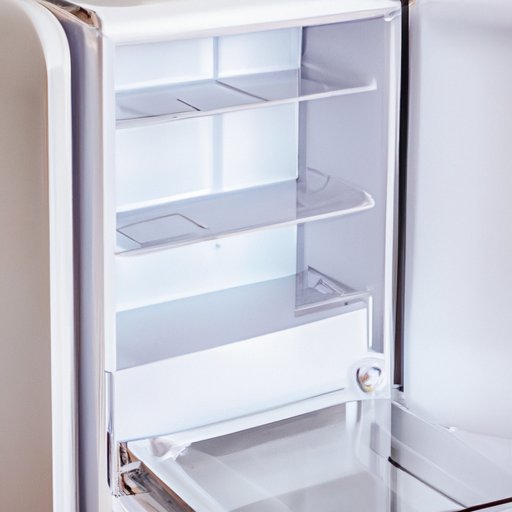Introduction
When it comes to refrigerators, one of the most common questions asked is “where is the coldest part?” It’s an important question, as the location of the coldest region can affect the freshness of stored food and the efficiency of the appliance. But what exactly is meant by “coldest part”? To answer this question, it is necessary to explore the different temperature variations within a refrigerator.
The purpose of this article is to examine the temperature differences within a typical refrigerator, identify the coldest spot, and discuss how to achieve maximum coolness. We will also look at how to maximize efficiency in your fridge and how to keep food fresher longer.
Exploring the Deepest Depths of a Refrigerator: Uncovering the Coldest Part
Temperature differences within a refrigerator are caused by several factors. The first is the placement of the fridge. If the appliance is located close to an external heat source, such as a stove or oven, then the inside of the fridge will be warmer than if it were located away from these sources. In addition, the size of the refrigerator and the amount of food it contains will also affect its internal temperature.
Another factor that affects the temperature within a refrigerator is the type of cooling system it has. Some fridges use a fan-driven cooling system, while others employ a static cooling system. Fan-driven systems are more efficient, as they circulate air around the interior of the fridge, thus ensuring even temperatures throughout. Static cooling systems, on the other hand, rely on natural convection currents to move air around, which can result in temperature variations.
An Analysis of the Temperature Differences Within a Refrigerator: What is the Coldest Spot?
In order to determine the coldest part of a refrigerator, it is necessary to analyze the temperature differences between different sections of the appliance. Generally speaking, the bottom shelf of the fridge tends to be the coldest spot, as it is closest to the cooling coils. However, this can vary depending on the type of cooling system and the size of the fridge.
It is also important to consider the temperature differences between shelves and drawers. Shelves tend to be colder than drawers, as the air circulation is better in the former. Additionally, the back wall of the fridge is usually colder than the front, as the cooling coils are located at the back.

How to Achieve Maximum Coolness in Your Fridge: Pinpointing the Coldest Region
If you want to find the coldest spot in your fridge, you can use a thermometer or other device to measure the temperature. Place the thermometer in various spots throughout the fridge and take note of the readings. This will help you identify the coldest region.
In addition to measuring the temperature, there are some tips you can follow to ensure maximum coolness in your fridge. Make sure the door seals tightly, as this will help prevent warm air from entering the fridge. Additionally, avoid overcrowding the shelves, as this can impede proper air circulation.

Chilling Out: Finding the Coldest Spot in Your Refrigerator
Once you’ve identified the coldest region of your fridge, you can start making changes to maximize its efficiency. Begin by rearranging the shelves and drawers to ensure maximum airflow. For example, place items that don’t need to be kept cold, such as condiments and beverages, on the top shelf, as this is usually the warmest part of the fridge.
You should also consider how you store food. Certain foods, such as dairy and meat, should be placed in the coldest part of the fridge. This will help them stay fresh longer. Additionally, try to avoid storing hot food directly in the fridge, as this can cause the temperature to rise.

Maximizing Efficiency in Your Fridge: Identifying the Coldest Part
The thermostat plays a crucial role in keeping your fridge running efficiently. Make sure it is set to the correct temperature. Most fridges should be set to 3°C (37°F) or lower. Additionally, you can place a fan at the back of the fridge to help circulate air and maintain consistent temperatures throughout.
Keeping Food Fresher Longer: Locating the Coldest Part of Your Refrigerator
If you want to keep food fresh for longer, you should make use of the freezer compartments in your fridge. These compartments are typically the coldest regions of the appliance, as they are insulated from the rest of the fridge. So, use them to store food that needs to be kept extra cold.
You should also consider placing food in the coldest part of the fridge. This will help ensure that it stays fresher for longer. Try to avoid leaving food out on the countertop for too long, as this can cause it to spoil quickly.
Conclusion
In conclusion, temperature variations within a refrigerator can have a significant impact on the efficiency of the appliance and the freshness of stored food. By exploring the temperature differences between shelves and drawers and using thermometers or other devices to pinpoint the coldest spot, you can maximize the efficiency of your fridge and keep food fresher longer.
By locating the coldest part of your refrigerator and taking steps to maximize efficiency, you can ensure that your food stays fresher for longer. Additionally, understanding the temperature variations within your fridge can help you save energy and money.


